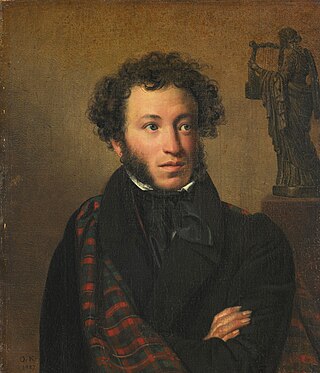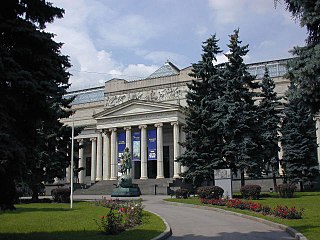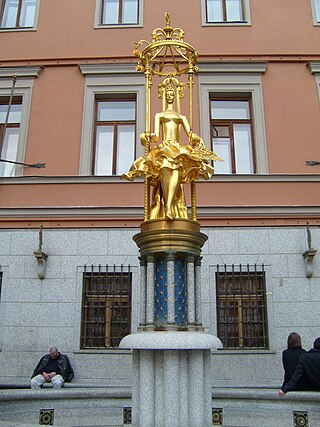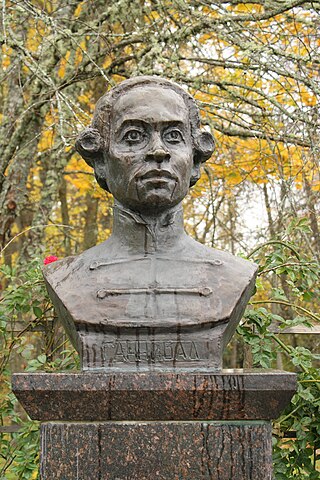
Alexander Sergeyevich Pushkin was a Russian poet, playwright, and novelist of the Romantic era. He is considered by many to be the greatest Russian poet and the founder of modern Russian literature.

The Pushkin State Museum of Fine Arts is the largest museum of European art in Moscow, located in Volkhonka street, just opposite the Cathedral of Christ the Saviour. The International musical festival Sviatoslav Richter's December nights has been held in the Pushkin Museum since 1981.

Ibrahim (Abai) Qunanbaiūly was a Kazakh poet, composer and Hanafi Maturidi theologian philosopher. He was also a cultural reformer toward European and Russian cultures on the basis of enlightened Islam. Among Kazakhs he is known simply as Abai.

Pushkin is a municipal town in Pushkinsky District of the federal city of St. Petersburg, Russia, located 24 kilometers (15 mi) south from the center of St. Petersburg proper, and its railway station, Tsarskoye Selo, is directly connected by railway to the Vitebsky Rail Terminal of the city. Population: 92,889 (2010 Census).

Queen's Park is an urban park in Downtown Toronto, Ontario, Canada. Opened in 1860 by Edward, Prince of Wales, it was named in honour of Queen Victoria. The park is the site of the Ontario Legislative Building, which houses the Legislative Assembly of Ontario. The phrase "Queen's Park" is regularly used as a metonym for the Government of Ontario or the Legislative Assembly of Ontario.
Alexander Pushkin (1799–1837) was a Russian poet.

Bowling Green is a small public park in the Financial District of Lower Manhattan, New York City, at the southern end of Broadway. Located next to the site of the original Dutch fort of New Amsterdam, it served as a public place before being designated as a park in 1733. It is the oldest public park in New York City and is surrounded by its original 18th-century fence. It included an actual bowling green and an equestrian statue of King George III prior to the American Revolutionary War.

Alexander Porfyrovych Archipenko was a Ukrainian-American avant-garde artist, sculptor, and graphic artist, active in France and the United States. He was one of the first to apply the principles of Cubism to architecture, analyzing human figure into geometrical forms.

Bronnitsy is a town in Moscow Oblast, Russia, located 54.5 kilometers (33.9 mi) southeast of central Moscow and 13 kilometers (8.1 mi) west of the Bronnitsy station on the Moscow–Ryazan railroad. The town is surrounded by Ramensky District but is administratively incorporated as a town under oblast jurisdiction. Population: 21,831 (2021 Census).

Tverskaya Street, known between 1935 and 1990 as Gorky Street, is the main radial street in Moscow. The street runs Northwest from the central Manege Square in the direction of Saint Petersburg and terminates at the Garden Ring, giving the name to Tverskoy District. The route continues further as First Tverskaya-Yamskaya Street, Leningradsky Avenue and Leningradskoye Highway.

Basmanny District is a district of Central Administrative Okrug of the federal city of Moscow, Russia. Population: 108,204 (2010 Census); 100,899 (2002 Census).

William Shakespeare has been commemorated in a number of different statues and memorials around the world, notably his funerary monument in Stratford-upon-Avon ; a statue in Poets' Corner in Westminster Abbey, London, designed by William Kent and executed by Peter Scheemakers (1740); and a statue in New York's Central Park by John Quincy Adams Ward (1872).

Alexander Nikolayevich Bourganov is a Russian sculptor, a National Artist of Russia, and a member of the Russian Academy of Fine Arts. His recent works include a monument to Alexander Pushkin located at George Washington University in Washington DC (2000); a statue of John Quincy Adams, the first U.S. Ambassador to Russia and later President of the United States, located in front of the U.S. Embassy in Moscow (2008); and a statue of poet Walt Whitman located on the campus of Moscow State University (2009). In 2001 his studio in Moscow was given the status of a State Museum, known as Bourganov's House. His other works around Moscow include a series of fountains and statues on Ukrainsky Boulvar, near the Hotel Ukraine.

Afro-Russians are people of African descent that have migrated to and settled in Russia. The Metis Foundation estimates that there were about 30,000 Afro-Russians in 2013.

Taras Hryhorovych Shevchenko was a Ukrainian poet, writer, artist, public and political figure, as well as folklorist and ethnographer. His literary heritage is regarded to be the foundation of modern Ukrainian literature and, to a large extent, the modern Ukrainian language. Shevchenko is also known for many masterpieces as a painter and an illustrator.

Pushkinskaya Street is one of the main streets in Rostov-on-Don. The street is named after the Russian poet Alexander Pushkin. Many old houses, university buildings, and the Don State Public Library are located on this street. The Pushkinskaya Street is a green boulevard, it goes parallel to the Don River.

The Emancipation Memorial, also known as the Freedman's Memorial or the Emancipation Group was a monument in Park Square in Boston. Designed and sculpted by Thomas Ball and erected in 1879, its sister statue is located in Lincoln Park in the Capitol Hill neighborhood of Washington D.C. The Boston statue was taken down by the City of Boston on December 29, 2020, following a unanimous vote from the Boston Art Commission on June 30 to remove the memorial.

Abram Petrovich Gannibal, also Hannibal or Ganibal, or Abram Hannibal or Abram Petrov, was a Russian military engineer, general-in-chief, and nobleman of African origin. Kidnapped and enslaved as a child by Ottomans, Gannibal was traded to Russia and presented as a gift to Peter the Great, where he was freed, adopted and raised in the Emperor's court household as his godson.

















